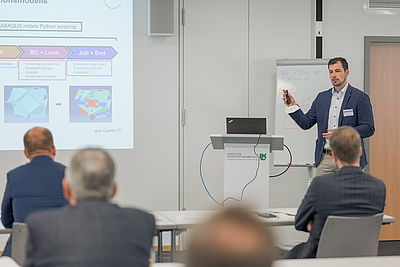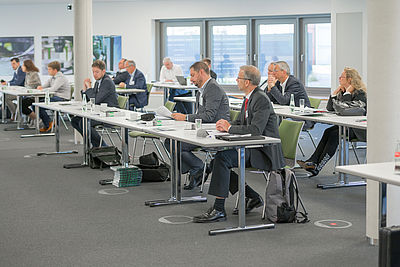Michel Baumgartner, General Secretary of EUROPUR AISBL, chaired the first event under the motto "no business as usual". His keynote paper focused above all on the many efforts being made by the industry to achieve a holistic circular economy and to digitise the entire value chain. He did, however, also point out the elementary importance of these approaches for the future development of the PU industry, especially when competing with alternative materials.
Following on from this concept, Dr. rer. nat. Alexander Chaloupka from the Netzsch Group presented the sensXPERT technology from the new corporate venture Netzsch Process Intelligence GmbH. Through the combination of sensors, material sciences and machine learning, processors in the field of polymers and polymer-based composites are assisted in the implementation of intelligent production for full component qualification during manufacture.
Dr.-Ing. Sonja Krömer from Frimo GmbH showed how the cloud-based documentation of machine data can, in addition to determining cycle times and productivity, also identify the energy distribution in the overall process, so that, in future, the energy consumption of all facilities can be efficiently reduced. In addition to this, the holistic machine monitoring procedure enables predictive maintenance of the machines and facilities.
Digitisation is not limited here to the processing and production of polyurethane parts. Getzner Werkstoffe GmbH, represented by Dipl.-Ing. Dirk Wehowsky, develops tailor-made PU elastomers for the vibration isolation of buildings and railway tracks. Sensor sleepers in the tracks make it possible to monitor the elastoplastic sleeper pads of polyurethane, with the result that product safety is enhanced and maintenance intervals can be increased.
Patrick Gahlen, M.Sc. from Covestro Deutschland AG presented an analysis of the anisotropic mechanical foam properties in PU-based composite elements by means of meso-scale FEM simulations. Through the simulation model, the mechanical properties of the composite elements can be calculated, taking into account the real foam structure.
Eduard Kremer, M.Sc. and Philipp Surray, M.Sc. then gave an insight into IKV‘s research activities that are geared to raising efficiency in the production of PU parts through the integration of inline systems and methods for analysing and correlating relevant process, material and component parameters. They also presented a new measuring system aimed at characterising the reaction enthalpy of fast-curing PU systems.
The sustainability of the PU segment through the recycling of end-of-life products is at the heart of the work carried out by H&S Anlagentechnik GmbH. Steffen Wiegmann, M.Sc. gave an introduction into the first industrial facilities in Europe for the recovery of polyols from end-of-life PU mattresses. In a 12-hour batch process, shredded mattress residues are converted by means of acidolysis or glycolysis into usable raw materials that can be processed – in the sense of a holistic circular economy – back into polyurethane mattresses or other products.
But it was not only the trends of digitisation and circular economy that were discussed. Dr. rer. nat. Marc Schürmann from Bomix Chemie GmbH presented some innovative applications and developments of release agents for the PU industry. Optimised release agents permit direct bonding without any previous cleaning or grinding. He also talked about some of the development work in which release agents can optimise the fire behaviour of polyurethane foams.
Following this successful event, we can report that IKV's next PU conference is already at the planning stage and is expected to take place in the spring of 2023.
Contact for questions
Philipp Surray, M.Sc.
+49 241 80-96960
philipp.surray@ikv.rwth-aachen.de


